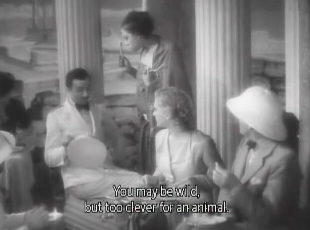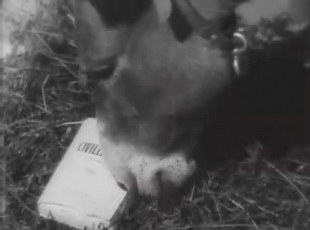|
Claudine Raynaud,
"Foil, Fiction, and Phantasm: 'Josephine Baker' in Princess Tam Tam" (page 5 of 10)
Just as the white upper classes took to slumming it in the Harlem
nightclubs and jazz joints, French high society—as pictured in the
film—would slum it in sailors' joints and bars. Analysts of the racial
and colonial imaginary of France in the 1920s and 1930s often fail to
note that the film also portrays "the people." Such vignettes of popular
Parisian life are recurrent during this period. This inclusion should be
stressed as an element that complicates a mere reading of "the French"
as all embodying the same degree of colonial arrogance and racist
bigotry. In Zou Zou, for example, Jean Gabin, who plays a sailor,
belongs to le petit peuple. While taking part in the colonial
venture, he participates in it differently than the young engineer of
Siren of the Tropics. Class distinctions are also part of the
complexity of the portrayal of the racialized and sexualized body within
the colonial imaginary.
In Princess Tam Tam, commonplaces about civilization and
savagery, nature and culture abound, such as this fragmented dialogue
with a gardener that seems crudely out of place. The gardener utters
peremptorily: "African flowers are not made for salons," as an answer to
Coton's earlier crude statement that "manure is natural." The Orient and
the Occident are systematically and simplistically opposed in a
cross-satire of civilized man and the fake exotic. When in one of the
early Tunisian scenes Alwina joins the aristocratic picnickers, she
replaces the salt with sand, spoils the dainty food, and forces the
group to abandon its table manners.[video] She plays a trick on the colonists
reminiscent of the slave's trickster tales. Then one of the closing
scenes, in which the maharajah reveals to Alwina the impossible dream of
participating in Western values (as Max de Mirecourt and his wife
embrace in a car) while the Orient beckons in the "shape" of Tahar, is
comically overdramatic. Alwina must give up on her "desire" to blend
into "civilization" through assimilation, and go back to her native land
where she belongs. The viewer must remember that this desire is only
explicit in the fictional sequence of the film. The film narrative also
portrays her as longing for home in her Parisian apartment as she
listens to music that reminds her of her country. Indeed, the Parisian
apartment contains fake flowers and palm trees, much to Alwina's
amazement. True and false, authentic and fake, are stereotypically
distributed as attributes of nature or civilization.

Princesse Tam Tam: Picnic at the Ruins [Back to text]
The reviews of La Revue Nègre emphasized Baker's link
to the primitive. The fantasy of transformation, metamorphosis, and
makeover, which nevertheless leaves the instinctual untouched, is still
underlined by reviewers when she becomes a film star: "Today's Josephine
Baker owes a lot to the Harlem adolescent imported into Europe: the
flavor of the same brutal spices burns under the skin of the educated
star, plied to more civilized tricks" (Alexandre Arnoux, Nouvelles
littéraires, M, 25). The rhythm of the conga that calls
Alwina back to her natural primitive dancing frames the film, as it is
featured in the opening sequence, underscoring the title of the film
"Tam Tam" or Tom-Tom, another name for the conga, a drum of African
origin derived from Congolese makuta drums.[24]
The narrative sequence
corresponding to the end of the novel thus shows that she must go back
and ends on the failure to "educate" Alwina: the spring cannot be tamed.
This failure echoes in reverse the earlier failure of the writer whose
inspiration has dried up—his wife screams: "Failure, failure, you are a
failure"—which once again sets civilization against instinct. A
caricature of the failed novelist, Max has written the novels Coeurs
en flammes, Ame trouble, and Les
Déclassés, whose titles reflect on the (poor) quality
and the genre (popular romance) of his writing. In sum, Max's literary
success is due to the coincidence of his story's correspondence with the
advent of modernism: the savage's revenge on civilization.
The other ending, the film's ending, is a closure that ironically
"seals" the fall of civilization in a burlesque mode.[video] "Returned" to
Tunisia, Josephine and the exotic Tahar become a couple and have a child
together. Tahar throws a clay pot and plays with the infant while Alwina
wanders through the colonial villa, given to her by Max, that she has
transformed into a chicken coop, where ducks and a donkey impose the
reign of the animal and represent the free. Domestic bliss is instituted
where it was not expected, as the film started with a Parisian domestic
row. The French urban and upper-class plot is relocated in the African
landscape. The spoiled aristocrats of the City of Light give way to a
Tunisian family idyll. Much has been said about the fact that Baker
never ends up marrying the white man in the films that were written to
promote her stage success, including in the Mémoires.[25]
Baker, however, did marry Jean Lion (1937) and Jo Bouillon (1947) in
real life: "As for me, Whites did marry me" (M, 241).

Princesse Tam Tam: Tunisian Squalor [Back to text]
Page: 1 | 2 | 3 | 4 |5 | 6 | 7 | 8 | 9 | 10
Next page
|